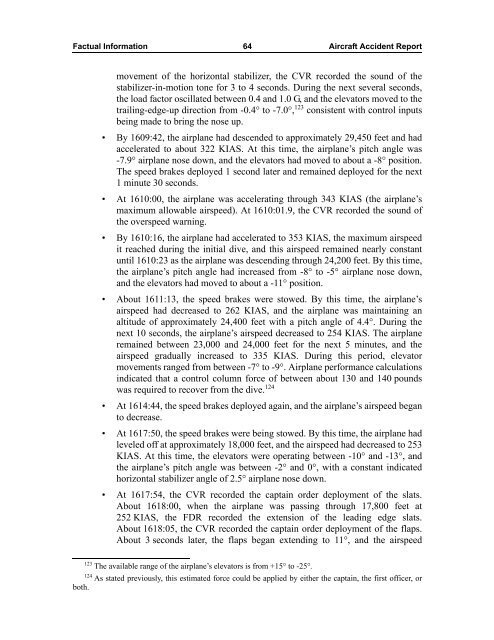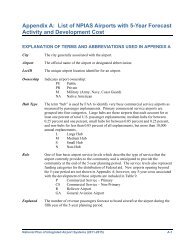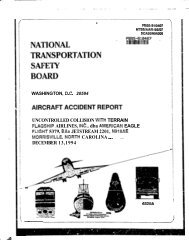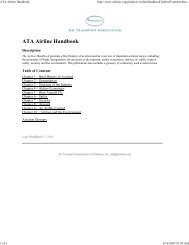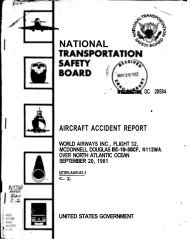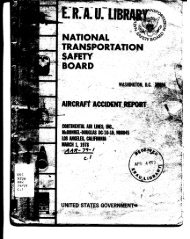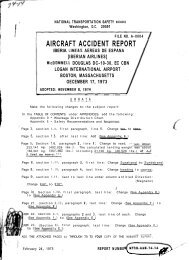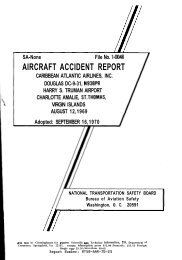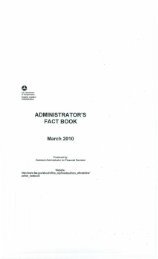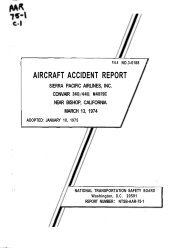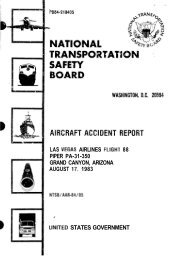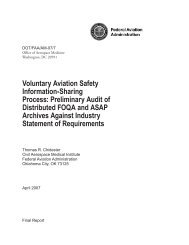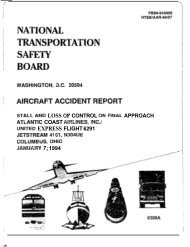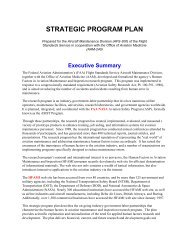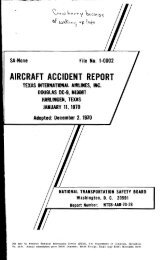NTSB/AAR-02/01
NTSB/AAR-02/01
NTSB/AAR-02/01
You also want an ePaper? Increase the reach of your titles
YUMPU automatically turns print PDFs into web optimized ePapers that Google loves.
Factual Information 64 Aircraft Accident Report<br />
movement of the horizontal stabilizer, the CVR recorded the sound of the<br />
stabilizer-in-motion tone for 3 to 4 seconds. During the next several seconds,<br />
the load factor oscillated between 0.4 and 1.0 G, and the elevators moved to the<br />
trailing-edge-up direction from -0.4° to -7.0°, 123 consistent with control inputs<br />
being made to bring the nose up.<br />
• By 1609:42, the airplane had descended to approximately 29,450 feet and had<br />
accelerated to about 322 KIAS. At this time, the airplane’s pitch angle was<br />
-7.9° airplane nose down, and the elevators had moved to about a -8° position.<br />
The speed brakes deployed 1 second later and remained deployed for the next<br />
1 minute 30 seconds.<br />
• At 1610:00, the airplane was accelerating through 343 KIAS (the airplane’s<br />
maximum allowable airspeed). At 1610:<strong>01</strong>.9, the CVR recorded the sound of<br />
the overspeed warning.<br />
• By 1610:16, the airplane had accelerated to 353 KIAS, the maximum airspeed<br />
it reached during the initial dive, and this airspeed remained nearly constant<br />
until 1610:23 as the airplane was descending through 24,200 feet. By this time,<br />
the airplane’s pitch angle had increased from -8° to -5° airplane nose down,<br />
and the elevators had moved to about a -11° position.<br />
• About 1611:13, the speed brakes were stowed. By this time, the airplane’s<br />
airspeed had decreased to 262 KIAS, and the airplane was maintaining an<br />
altitude of approximately 24,400 feet with a pitch angle of 4.4°. During the<br />
next 10 seconds, the airplane’s airspeed decreased to 254 KIAS. The airplane<br />
remained between 23,000 and 24,000 feet for the next 5 minutes, and the<br />
airspeed gradually increased to 335 KIAS. During this period, elevator<br />
movements ranged from between -7° to -9°. Airplane performance calculations<br />
indicated that a control column force of between about 130 and 140 pounds<br />
was required to recover from the dive. 124<br />
• At 1614:44, the speed brakes deployed again, and the airplane’s airspeed began<br />
to decrease.<br />
• At 1617:50, the speed brakes were being stowed. By this time, the airplane had<br />
leveled off at approximately 18,000 feet, and the airspeed had decreased to 253<br />
KIAS. At this time, the elevators were operating between -10° and -13°, and<br />
the airplane’s pitch angle was between -2° and 0°, with a constant indicated<br />
horizontal stabilizer angle of 2.5° airplane nose down.<br />
• At 1617:54, the CVR recorded the captain order deployment of the slats.<br />
About 1618:00, when the airplane was passing through 17,800 feet at<br />
252 KIAS, the FDR recorded the extension of the leading edge slats.<br />
About 1618:05, the CVR recorded the captain order deployment of the flaps.<br />
About 3 seconds later, the flaps began extending to 11°, and the airspeed<br />
123 The available range of the airplane’s elevators is from +15° to -25°.<br />
124<br />
As stated previously, this estimated force could be applied by either the captain, the first officer, or<br />
both.


